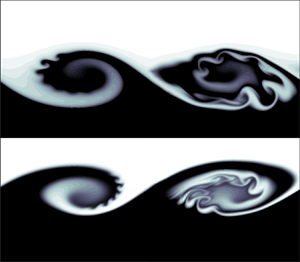Article contents
Optimal growth over a time-evolving variable-density jet at Atwood number  $\vert \textit {At} \vert = 0.25$
$\vert \textit {At} \vert = 0.25$
Published online by Cambridge University Press: 11 February 2022
Abstract

Secondary instabilities growing over a time-evolving variable-density round jet subject to the primary Kelvin–Helmholtz (KH) instability at Atwood number  $\vert \textit {At} \vert = 0.25$ are investigated with a non-modal linear stability analysis. Despite local modifications of the base flow vorticity induced by the baroclinic torque, these disturbances experience a short-term universal growth due to a combination of the Orr and lift-up mechanisms, whatever the azimuthal wavenumber
$\vert \textit {At} \vert = 0.25$ are investigated with a non-modal linear stability analysis. Despite local modifications of the base flow vorticity induced by the baroclinic torque, these disturbances experience a short-term universal growth due to a combination of the Orr and lift-up mechanisms, whatever the azimuthal wavenumber  $m$. At
$m$. At  $\textit {Re}=1000$, the secondary energy growth stems from the development of elliptical and hyperbolic instabilities, with an E-type-to-H-type transition as
$\textit {Re}=1000$, the secondary energy growth stems from the development of elliptical and hyperbolic instabilities, with an E-type-to-H-type transition as  $m$ and
$m$ and  $\textit {Re}$ increase, as in the homogeneous case (Nastro et al., J. Fluid Mech., vol. 900, 2020, A13). In the light jet at
$\textit {Re}$ increase, as in the homogeneous case (Nastro et al., J. Fluid Mech., vol. 900, 2020, A13). In the light jet at  $\textit {Re} = 1000$, after the KH mode saturation, the high-
$\textit {Re} = 1000$, after the KH mode saturation, the high- $m$ H-type instability is replaced by a perturbation organised as counter-rotating streamwise vortices located in the base flow region of promoted strain rate. Increasing the Reynolds number up to
$m$ H-type instability is replaced by a perturbation organised as counter-rotating streamwise vortices located in the base flow region of promoted strain rate. Increasing the Reynolds number up to  $\textit {Re} = 10\,000$ yields larger energy growths and a strong anisotropy among energy and enstrophy components with a preferential increase of axial velocity and azimuthal vorticity. Both come from the linearised baroclinic source that drives the optimal response towards folded sheets of axial velocity that differ from those observed in the variable-density plane shear layers. When the perturbation is injected around the KH saturation time for
$\textit {Re} = 10\,000$ yields larger energy growths and a strong anisotropy among energy and enstrophy components with a preferential increase of axial velocity and azimuthal vorticity. Both come from the linearised baroclinic source that drives the optimal response towards folded sheets of axial velocity that differ from those observed in the variable-density plane shear layers. When the perturbation is injected around the KH saturation time for  $\textit {Re}=10\,000$, the response to optimal perturbation takes the form of fast growing secondary KH instabilities whatever
$\textit {Re}=10\,000$, the response to optimal perturbation takes the form of fast growing secondary KH instabilities whatever  $m$. We find these three-dimensional secondary KH instabilities to be good candidates for the transition to turbulence in variable-density jet flows.
$m$. We find these three-dimensional secondary KH instabilities to be good candidates for the transition to turbulence in variable-density jet flows.
JFM classification
- Type
- JFM Papers
- Information
- Copyright
- © The Author(s), 2022. Published by Cambridge University Press
References
REFERENCES
- 4
- Cited by



